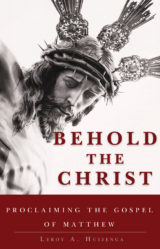By Leroy Huizenga
Leroy A. Huizenga is Administrative Chair of Human and Divine Sciences at the University of Mary in Bismarck, ND. He is the author of Behold the Christ: Proclaiming the Gospel of Matthew.

Contemporary Gnosticism is a totalizing ideology that brooks no opposition and tolerates no dissent. It wants to separate humans from all tradition and social locations (family, community, and so on) that serve as natural points of opposition. Separated from tradition, family, culture, and nature, the individual becomes a subject of the State facing the stick of coercion. But there’s also a carrot. Like all ideologies, contemporary Gnosticism entices postmodern men and women with promises of a perfect utopia, a heaven on earth in the here and now, if only we trust elites to run with their plans for us.
Gnosticism is our root worldview, and it issues forth today on a more practical level as “Moral Therapeutic Deism,” a phrase coined by sociologists Christian Smith and Melissa Lundquist Denton in Soul Searching: The Religious and Spiritual Lives of American Teenagers. They summarize Moral Therapeutic Deism (MTD) in five points:
- A God exists who created and orders the world and watches over human life on earth.
- God wants people to be good, nice, and fair to each other, as taught in the Bible and by most world religions.
- The central goal of life is to be happy and to feel good about oneself.
- God does not need to be particularly involved in one’s life except when God is needed to resolve a problem.
- Good people go to heaven when they die.
“Deism” is the idea that God made the world and then stepped away from it. God’s not intimately involved; there is no Providence. “Moral” comes from the concern to be a generally good person. “Therapeutic” concerns feelings and brings us closest to Gnosticism: we live in a therapeutic age, in which feelings dominate and now determine much in religion, culture, politics, and law.
Finally, our contemporary age of Moral Therapeutic Deism seeks to reimagine Jesus as a mascot for its ideology. Modernist Christianity, rooted in the Enlightenment, sought to adapt its understanding of Christian faith to the latest knowledge in secular domains—the sciences, hard and soft, as well as philosophy and ethics. It therefore was, and is, embarrassed by the miraculous and the sacrificial, both of which belonged to an unscientific premodern age. And so modernist Christians sought to save the faith for modernity by purifying it of all that modernity rejects. What is left over is ethics; Jesus is preserved as a great moral teacher of enduring relevance through demythologization— that is, through stripping away the miraculous and sacrificial myths around his legend and going “behind the Gospels” to find a historical Jesus congenial to the spirit of the age. Even here, however, with regard to ethics, Jesus is understood to teach what the Enlightenment believed anyway, and so Jesus was remade in the image of (say) the German Philosopher Immanuel Kant.
So too now in our postmodern age. We make a malleable Messiah in our image, a tolerant, inclusive Jesus, a breaker of all boundaries who does so purely for the sake of transgression, and all those who would insist on maintaining religion’s traditional rules and rituals are written off as rigid, pilloried as Pharisees. Far from seeing him as our Master, the postmodern age makes Jesus our mascot, the one who affirms our favored causes and affirms us in our deepest selves, where we find ourselves defined by our severest desires.
But that means we’re trapped; in our desire to escape from all constraints, we’re constrained by desire. We’re imprisoned by our very selves, slaves to our passions, even making them the determiners of our very identity. Trying to find an escape from our bodies, we find ourselves ensnared even more deeply by the passions that define ourselves. And as St. Augustine famously prayed to God, “Without you, what am I to myself but a guide to my own self-destruction?”
St. Augustine’s solution to self-entrapment in one’s own passions is the gospel: God, both the Creator outside of us creatures and yet also inside us, is closer to us than we are to ourselves: “You were more inward than my most inward part and higher than the highest element within me.” And this Creator God comes to us in Jesus Christ to reorder our disordered passions and restore us to our true selves found only in Christ.
You Might Also Like

Behold the Christ: Proclaiming the Gospel of Matthew, by Leroy A. Huizenga, reveals the significance of St. Matthew’s Jesus: He is Emmanuel, God with us always, who saves his people from their sins by dying for them. Keyed to the lectionary and featuring a section on the relevance of St. Matthew’s Gospel for our contemporary age, Behold the Christ will make the Gospel and indeed the Faith real to today’s readers.

